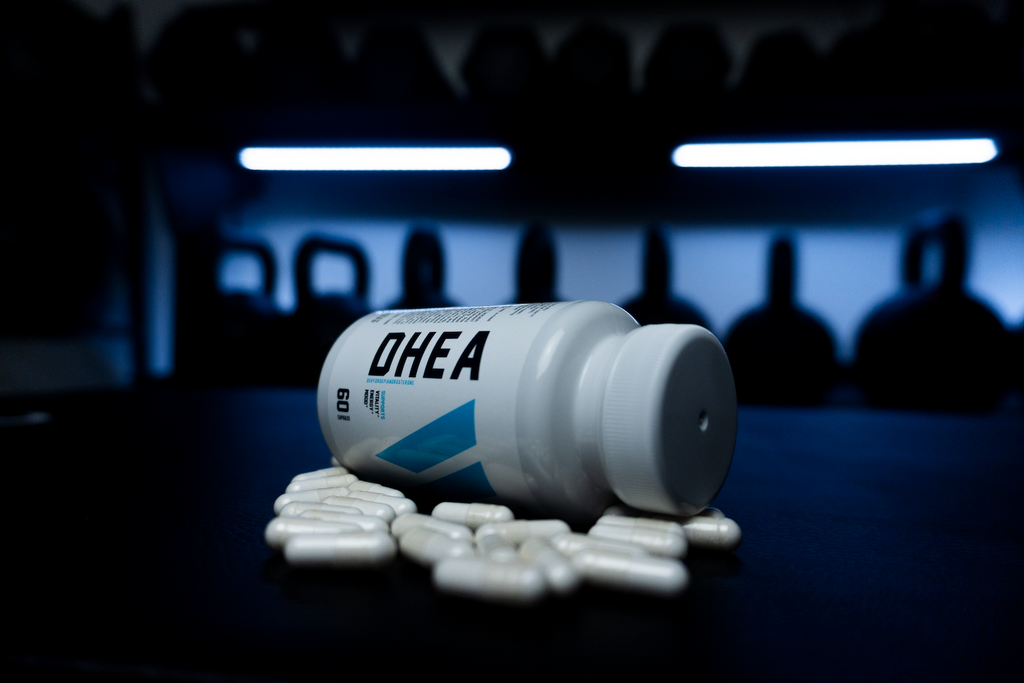
DHEA (dehydroepiandrosterone) is one of the most commonly used over-the-counter hormone-support supplements — often taken to support testosterone, estrogen balance, mood, energy, and recovery. But what happens when you stop taking it?
Whether you’re cycling off DHEA after a post-cycle therapy (PCT), coming off long-term use for hormone optimization, or just experimenting with dosage, it’s important to understand how your body may respond once supplementation ends.
Some users report smooth transitions, while others experience symptoms like:
→ Low energy and brain fog
→ Mood swings or emotional flatness
→ Reduced libido
→ Sluggish recovery or adrenal fatigue symptoms
These effects don’t hit everyone the same way — and they can depend on how long you used DHEA, the dose, and your current hormonal baseline.
In this guide, we’ll break down how DHEA works, what to expect when you stop taking it, and how to manage the transition with smart strategies and natural support.
What Is DHEA and Why Do People Take It?
DHEA (dehydroepiandrosterone) is a naturally occurring hormone produced by the adrenal glands, and to a lesser extent, the gonads and brain. It serves as a precursor to both testosterone and estrogen, playing a key role in hormonal balance, metabolic health, immune function, and overall vitality.
DHEA levels peak in early adulthood and gradually decline with age — often dropping by 50% or more by the time you reach your 40s. Chronic stress, overtraining, and certain medical conditions can accelerate this decline.
→ Common Reasons People Supplement with DHEA:
→ To support testosterone production during low-test states or PCT
→ To help balance estrogen in men or women during hormone fluctuations
→ To improve energy, mood, and libido
→ To support immune function and reduce inflammation
→ As part of anti-aging, fertility, or adrenal fatigue protocols
“DHEA supplementation may restore declining androgen levels and improve quality of life in individuals with adrenal insufficiency, aging, or hypogonadism,” notes Weiss et al., Endocrine Practice.
→ Swolverine’s Recommended Option:
-
DHEA – 100mg
→ Clinically dosed to support androgen levels, mood, and post-cycle recovery
→ Typically used for 4–12 week cycles, depending on need
Whether you’re using DHEA to bridge a hormone gap or enhance recovery, knowing what to expect after you stop is key to maintaining your results and health.
How DHEA Works in the Body
DHEA acts as a hormonal precursor — meaning it helps the body create more potent sex hormones like testosterone, dihydrotestosterone (DHT), and estradiol. While it’s not anabolic on its own, its role in the endocrine cascade makes it essential for maintaining hormonal balance, especially as you age or come off suppressive compounds.
It’s primarily produced by the adrenal cortex, but also synthesized in small amounts by the testes, ovaries, and brain. Once in circulation, DHEA can be converted into either androgens or estrogens depending on tissue needs, enzyme activity, and your individual hormonal profile.
→ Key Functions of DHEA Include:
→ Supporting testosterone and estrogen balance
→ Modulating immune function and inflammation
→ Enhancing mood, cognitive function, and stress resilience
→ Aiding in recovery, energy, and libido
→ Supporting bone density and insulin sensitivity
“DHEA influences multiple systems via its androgenic and estrogenic conversion pathways, and may impact everything from immune response to mood to metabolic regulation,” notes Traish et al., Current Drug Targets.
Because of its versatility, DHEA supplementation is often used during PCT, periods of adrenal burnout, or natural testosterone support protocols.
But what happens when you pull it out of your stack?
What Happens When You Stop Taking DHEA?
Stopping DHEA — especially after prolonged use or high doses — can lead to a range of physiological and psychological effects as your body recalibrates its own hormone production.
Since DHEA supports your body’s natural testosterone and estrogen balance, suddenly removing it may leave a temporary hormonal gap, particularly if your adrenal function was already sluggish or suppressed.
→ Common Symptoms After Stopping DHEA:
→ Fatigue and Low Energy: Without DHEA’s support, cortisol and adrenal output may become more noticeable, especially under stress.
→ Mood Changes: DHEA is linked to mood stabilization; its absence can lead to irritability, low motivation, or even mild depressive symptoms.
→ Reduced Libido: A drop in DHEA may reduce sex hormone availability, affecting arousal and performance.
→ Slower Recovery: If used during PCT or for workout recovery, removing DHEA can prolong soreness or muscle fatigue.
→ Hormonal Fluctuations: Estrogen and testosterone levels may dip temporarily while your endocrine system adjusts.
“Discontinuing DHEA may lead to a decline in serum androgens, and in some cases, exacerbate symptoms of androgen deficiency,” according to Morales et al., Journal of Clinical Endocrinology & Metabolism.
These symptoms vary by person — some rebound quickly, while others take weeks to stabilize. Factors like age, stress, pre-existing adrenal function, and dosage all play a role.
How Long Does DHEA Stay in Your System?
Although DHEA’s half-life is relatively short, its effects on hormone levels can persist longer depending on your dosage, duration of use, and metabolism.
→ DHEA Pharmacokinetics:
-
Half-life: Roughly 15 to 38 minutes for DHEA itself
-
DHEA-S (sulfated form): Can remain in circulation for 7 to 22 hours
-
Metabolite retention: Hormonal effects (especially androgenic) may last several days to a week post-discontinuation
While the compound itself clears your bloodstream quickly, the physiological effects on testosterone, estrogen, and mood can take longer to level out — especially if you’ve been on high doses or long-term regimens.
According to Regelson et al., Annals of the New York Academy of Sciences, DHEA-S levels can remain elevated for several days after oral administration, depending on formulation and individual metabolism.
This is why some users experience a delayed “crash” 1–3 days after stopping — as hormonal output drops faster than the body can compensate.
Will Your Body Stop Producing DHEA Naturally?
One of the biggest concerns when stopping any hormone-affecting supplement is whether it will suppress your body’s natural production. In the case of DHEA, the risk of long-term suppression is low, but not impossible — especially at high doses or extended use.
→ What the Research Suggests:
-
Short-term DHEA use (under 12 weeks) at low to moderate doses (25–50 mg/day) is unlikely to suppress endogenous production in healthy individuals.
-
Higher doses (75–100 mg or more daily), especially over long periods, may blunt adrenal DHEA output through negative feedback on the hypothalamic-pituitary-adrenal (HPA) axis.
-
The body typically rebounds within a few weeks after stopping, though this can vary with age, stress levels, and underlying adrenal health.
“Physiological replacement doses of DHEA appear to have minimal suppressive effect on endogenous steroidogenesis,” notes Kroboth et al., Clinical Pharmacokinetics.
→ Signs Your DHEA Production May Be Sluggish:
→ You relied heavily on DHEA for energy or libido
→ You experience fatigue, low motivation, or brain fog after stopping
→ Hormone panels show suppressed DHEA-S or testosterone
→ You’ve been under chronic stress or overtraining
In these cases, natural HPA-axis recovery support can help your system re-regulate more effectively.
How to Manage Symptoms After Stopping DHEA
If you’re experiencing symptoms like low energy, hormonal imbalance, or poor recovery after stopping DHEA, there are targeted strategies that can support your body’s transition and speed up hormonal recalibration.
→ 1. Taper Your Dose Gradually (If Possible)
Instead of stopping cold turkey, reduce your DHEA dose over 1–2 weeks. This can minimize hormonal whiplash and give your body time to adapt.
→ Example:
→ 2. Support Adrenal Recovery
After stopping DHEA, adrenal glands may need time to normalize. Support them with:
→ Sleep hygiene and reduced stimulants
→ Electrolytes to maintain hydration and cortisol rhythm
→ Adaptogens like ashwagandha or rhodiola
→ ZMT to naturally support testosterone, sleep, and endocrine health
→ 3. Enhance Recovery and Stress Resilience
Use post-training and lifestyle supplements that blunt the physical stress response and improve repair.
→ POST — includes Setria® glutathione, collagen, MSM, and pomegranate extract to reduce inflammation and improve joint/tissue recovery
→ INTRA — full-spectrum EAAs and electrolytes to support hydration, training, and protein synthesis during a cut or low-energy phase
→ 4. Reassess With Bloodwork (If Needed)
If symptoms persist longer than 3–4 weeks, test:
→ DHEA-S
→ Total and free testosterone
→ Estradiol
→ Cortisol (AM)
→ LH/FSH (if concerned about suppression)
These labs help identify whether hormone levels are stabilizing or if additional support (like natural testosterone boosters or medical treatment) is needed.
Should You Cycle DHEA or Take It Long Term?
Unlike anabolic steroids or prescription testosterone, DHEA is available over the counter, and many users assume it’s safe for long-term use without a break. But as with any hormone-affecting compound, cycling DHEA is generally the smarter approach — especially for athletes, bodybuilders, or anyone using it to support recovery or post-cycle hormone balance.
→ Why You Should Cycle DHEA:
→ Prevents potential suppression of adrenal DHEA production
→ Reduces the risk of estrogen conversion or hormonal imbalance
→ Allows you to re-evaluate baseline hormone levels
→ Minimizes the chance of tolerance or desensitization to its effects
A typical DHEA cycle looks like:
“Chronic DHEA use may lead to changes in androgen:estrogen balance and downstream signaling. Cycling allows better control of these effects,” notes Labrie et al., Journal of Steroid Biochemistry & Molecular Biology.
Long-term use may be appropriate for older adults with clinically low DHEA-S levels, but it should be guided by lab work and monitored by a healthcare provider.
Legal Status and Disclaimer
In the United States, DHEA is legal to purchase over the counter as a dietary supplement under the Dietary Supplement Health and Education Act (DSHEA) of 1994. However, DHEA is classified by the World Anti-Doping Agency (WADA) as a prohibited substance during competition due to its potential for performance enhancement and androgenic effects.
Athletes subject to drug testing — including those in CrossFit, USAPL, NCAA, or Olympic competition — should avoid DHEA unless they’ve received a therapeutic use exemption (TUE).
Disclaimer: This content is for informational and educational purposes only. It is not medical advice. Always consult with your healthcare provider before starting, stopping, or cycling hormonal supplements like DHEA — especially if you have a history of hormone-related conditions.
Conclusion: What Happens When You Stop Taking DHEA?
DHEA can be an incredibly useful supplement — whether you’re recovering from a cycle, addressing low androgen levels, or optimizing performance and mood. But what happens after you stop matters just as much as when you start.
Here’s what to remember:
→ Stopping DHEA can lead to temporary fatigue, mood changes, and hormonal shifts, especially after long-term use
→ Your body can and often will restart natural production, but adrenal and hormonal support can help smooth the transition
→ Smart strategies like tapering, using recovery supplements, and blood testing can prevent setbacks
→ Swolverine’s DHEA and ZMT offer clean, clinically dosed options to support endocrine health naturally
If you’re using DHEA as part of a PCT protocol, adrenal reset, or long-term hormone strategy, cycling on and off with intention is key to maintaining balance, energy, and results.





